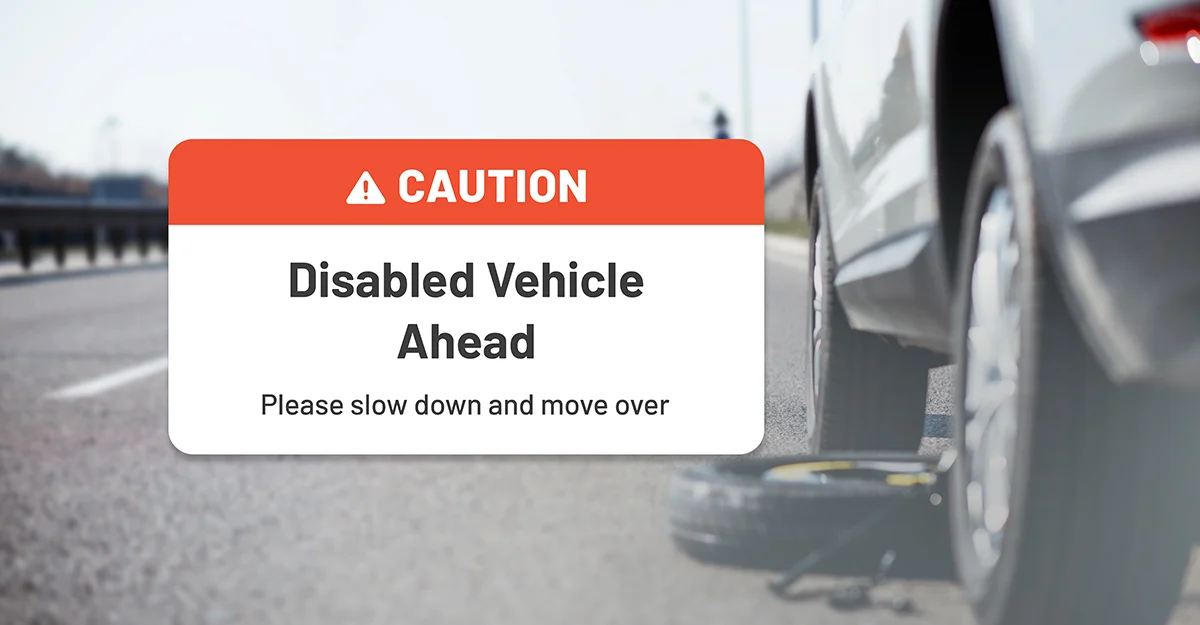
Disabled Motorist Alerts Now Available on Safety Cloud®
HAAS Alert is partnering with Auto Club Enterprises, the country’s largest AAA motor club, to automatically notify drivers through Safety Cloud® digital alerts to slow down and move over when approaching a stranded motorist on the roadside.
A recent study from the AAA Foundation for Traffic Safety reveals the number of roadside assistance providers struck and killed while working on the side of the road is four times higher than what is reported. With these digital alerts, AAA members and tow operators will be better protected.
Digital alerts are available to members in select ACE Club regions, including:
- Alabama
- Northern New England: Maine, New Hampshire, Vermont
- East Central: Parts of Pennsylvania, Ohio, Kentucky, West Virginia, New York
- Tidewater: Southeastern Virginia
- Missouri: Along with Arkansas, Mississippi, Louisiana, and parts of Kansas, Illinois, Indiana
- Texas
- New Mexico
- Southern California: From Mono to San Diego Counties
- Hawaii
When a AAA member requests roadside assistance from a hazardous area, their location will be broadcasted to drivers using navigation app Waze and 2018 and newer Stellantis vehicles through Safety Cloud digital alerts. Drivers using these vehicles and platforms do not have to change any settings to receive roadway safety alerts. Once the AAA technician arrives, the digital alert will update to inform approaching drivers about the tow vehicle's presence. This gives drivers extra time to safely slow down or move aside, enhancing safety for everyone involved.
“Too often, the lives of our members stranded at roadside and our heroic tow technicians who come to their rescue are put in unnecessary danger by inattentive and risky drivers,” said Nannalee Haywood, AAA Vice President of Automotive Services. “By automatically alerting nearby drivers to the location of an emergency roadside assistance call in real time, we can reduce the likelihood that drivers are caught off-guard when approaching a tow truck on the side of the road.”
As of 2023, more than 3,300 fleets and agencies nationwide are equipped with Safety Cloud, with alerts reaching an estimated 72.8 million drivers. Studies have found driver advanced warning systems, like digital alerting, reduce the likelihood of a collision by up to 90% and reduce hard braking near roadway incidents by 80%.
“We are thrilled to launch this lifesaving integration with AAA, which marks the first time that digital alerts will be used in the field to protect disabled motorists as well as the technicians that service them,” said Cory Hohs, CEO of HAAS Alert. “It’s an honor to work in partnership with an organization that has led the nation in roadway safety for over a century, and we know that this joint effort will save lives.”
Examining Characteristics of Fatal Roadside Worker Crashes
Struck and killed incidents are nearly four times more than reported. It’s the chilling reality for roadside assistance providers, including tow truck drivers, mobile mechanics, emergency roadside technicians, and safety service patrols who put themselves at risk every day to help others.
AAA Foundation researchers combed through diverse information sources and uncovered 123 roadside assistance providers killed by passing vehicles between 2015 and 2021. This grim figure dwarfs the approximate 34 noted in national crash data. The discrepancy is due to gaps in crash report forms that incorrectly record victims who are roadside assistance providers as "pedestrians." While yearly total traffic fatalities increased significantly over the study period, the data suggest that roadside assistance provider fatalities increased even more.
Key findings involving emergency responder fatalities
- 89% occurred at locations with speed limits of 55 miles per hour or higher, almost all of which were on Interstates or other limited-access highways.
- 84% occurred in crashes with no indication of precipitation nor slippery road conditions.
- 63% occurred during darkness, of which nearly two-thirds were at locations without lighting.
- 63% occurred in crashes in which the striking vehicle left the road before striking the roadside assistance provider, the provider’s vehicle, or the disabled vehicle.
AAA urges action on several fronts:
- Slow down, move over: Reinforce these life-saving laws, reminding drivers to give space to ANYONE (including but not limited to roadside assistance, police, fire, EMS) working on the side of the road. Every ounce of awareness could be the difference between life and death.
- Shield the vulnerable: Utilize countermeasures to prevent vehicles from striking workers. The AAA Foundation previously examined vehicle-mounted electronic variable message signs and found them effective at alerting drivers to slow down and move over.
- Train for survival: Teach roadside workers to prioritize work away from traffic and equip them with strategies to avoid harm's way. Training for roadside assistance providers should emphasize the importance of not working or standing on the traffic-facing side of the incident whenever possible and minimize time spent on the traffic-facing side of the scene.
About AAA
Started in 1902 by automotive enthusiasts who wanted to chart a path for better roads in America and advocate for safe mobility, AAA has transformed into one of North America’s largest membership organizations. Today, AAA provides roadside assistance, travel, discounts, financial and insurance services to enhance the life journey of 64 million members across North America, including 57 million in the United States. To learn more about all AAA has to offer or to become a member, visit AAA.com or download the AAA Mobile app.
About HAAS Alert
HAAS Alert makes roads and communities safer by delivering digital alerts from emergency response and other municipal fleets to nearby drivers. The company streams real-time alerts and other vital safety information to motorists and connected cars via in-vehicle and navigation systems when emergency vehicles are approaching and on-scene. For emergency response and roadway fleets interested in joining the Safety Cloud, click below to get equipped.











